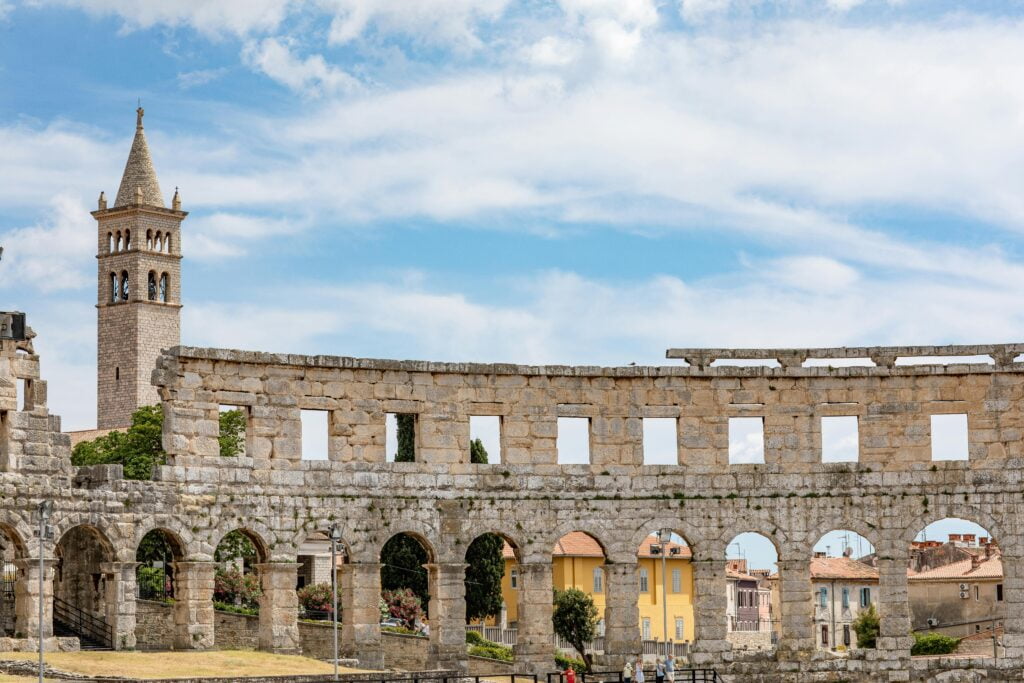Istria’s Ancient Roman Treasure
Pula, a seafront city on the tip of Croatia’s Istrian Peninsula, is a captivating blend of ancient Roman architecture, Venetian fortresses, and vibrant Mediterranean culture. Known for its well-preserved Roman amphitheater, the Arena, Pula offers visitors a unique journey through time. With its crystal-clear waters, beautiful beaches, and proximity to the Brijuni Islands National Park, Pula is an ideal destination for history enthusiasts, nature lovers, and sun-seekers alike.
Essential Pula Information
- Language: Croatian (Italian widely spoken; English common in tourist areas)
- Currency: Croatian Kuna (HRK)
- Timezone: Central European Time (CET) UTC+1 (UTC+2 from last Sunday in March to last Sunday in October)
- Visas: Croatia is part of the EU but not yet in the Schengen Area (as of 2023)
- Tipping: 10% is customary in restaurants if service charge is not included
Where to Stay in Pula: Top Neighborhoods for Tourists
City Center
The heart of Pula, the city center is home to most of the major historical attractions, including the Arena and the Temple of Augustus. Staying here puts you within walking distance of numerous restaurants, cafes, and shops. It’s ideal for those who want to immerse themselves in Pula’s rich history and vibrant urban atmosphere.
Verudela Peninsula
Located about 3 km south of the city center, Verudela Peninsula is a popular resort area known for its beautiful beaches and crystal-clear waters. It’s perfect for families and those seeking a relaxing beach holiday while still being close to the city’s attractions. The area offers a range of accommodation options and water sports activities.
Stoja
Stoja is a peaceful neighborhood southwest of the city center, offering a more local experience. It features several small, secluded beaches and coves, perfect for those looking to escape the crowds. The area is also home to a campsite, making it popular with nature lovers and budget travelers.
Pješčana Uvala
Also known as Sandy Bay, this small resort area is located about 3 km southeast of Pula. It offers a sheltered beach, calm waters, and a relaxed atmosphere, making it ideal for families with children. The bay is surrounded by pine forests, providing a picturesque setting for a peaceful vacation.
Must-See Sights in Pula
- Pula Arena: One of the best-preserved Roman amphitheaters in the world, dating back to the 1st century AD.
- Temple of Augustus: A well-preserved Roman temple in the heart of the old town.
- Arch of the Sergii: A Roman triumphal arch dating from the 1st century BC.
- Forum: The main square of ancient and modern Pula, home to the Temple of Augustus and other historical buildings.
- Pula Cathedral: A 6th-century church with elements added over the centuries.
- Fort Punta Christo: A 19th-century Austro-Hungarian fortress offering panoramic views of the city and sea.
Discover Pula’s Hidden Gems
- Underground Tunnels (Zerostrasse): A network of underground tunnels built during WWI, now used for exhibitions.
- Lighting Giants: The cranes of Uljanik Shipyard illuminated at night in a unique light show.
- Cape Kamenjak: A nature park south of Pula with stunning cliffs, beaches, and dinosaur footprints.
- Aquarium Pula: Located in the Verudela Peninsula, housed in an old Austro-Hungarian fortress.
- Memo Museum: A quirky museum showcasing everyday items from the Yugoslav era.
Food Highlights: Must-Try Istrian Dishes in Pula
- Istrian Fuži: Handmade pasta often served with truffles or various meat sauces.
- Istrian Pršut: Air-dried ham similar to Italian prosciutto but with a distinct flavor.
- Brodetto: A rich fish stew typically made with several types of fish and polenta.
- Istrian Maneštra: A hearty vegetable and bean soup, sometimes made with pork.
- Biska: A local brandy made from mistletoe, unique to the Istria region.
6 Essential Tips for Visiting Pula
- Arena Events: Check the schedule for concerts and events at the Pula Arena for a unique historical venue experience.
- Brijuni National Park: Take a day trip to this stunning archipelago, once the summer residence of President Tito.
- Olive Oil Tasting: Istria is known for its high-quality olive oil. Join a tasting tour to sample some of the best.
- Pula Film Festival: If visiting in July, don’t miss this prestigious film festival held in the historic amphitheater.
- Dimensions Festival: Electronic music fans should consider timing their visit with this festival held in Fort Punta Christo.
- Bike Rental: Rent a bike to explore the city and its surroundings, including the scenic coastline and Šijana Forest.
How to Get to Pula
Air: Pula Airport (PUY) is the main gateway to the city:
- Located about 6 km northeast of Pula city center.
- Handles both domestic and international flights, with increased traffic during summer months.
- Connected to the city by airport shuttle buses and taxis.
Ferry: Pula is well-connected by sea to other Adriatic destinations:
- Regular ferries connect Pula to nearby islands like Unije, Susak, and Mali Lošinj.
- A high-speed catamaran service operates between Pula and Venice during the summer season (June to September). The journey takes about 3.5 hours, offering a unique way to travel between Croatia and Italy.
Bus: Pula is well-connected by bus to other Croatian cities and some international destinations:
- The main bus station is located near the city center, about a 10-minute walk from the Arena.
- Regular bus services connect Pula to major Croatian cities like Zagreb, Rijeka, and Split.
Car: Pula is easily accessible by car:
- The Istrian Y highway connects Pula to the Slovenian and Italian border.
- The coastal road offers a scenic route for those driving from other Istrian towns.




